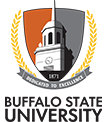Information for Parents and Families
The transition from high school to higher education is an exciting time for students. It provides students an opportunity:
- For personal growth through self-advocacy
- Understanding functional abilities
- Identifying tools that provides access
- Develop communication skills
| High School | Buffalo State University |
|---|---|
| High school accommodations are about success | University accommodations are about equal access |
| The school arranges communications with teachers about accommodations | The student communicates with faculty about accommodations |
| Student has a 504 Plan or an IEP | Students get a Letter of Accommodation |
| Parents/guardians act as primary advocate | Student is their own primary advocate |
Sources of Documentation at Buffalo State University Compared to High School
Students are the first source of information about why an accommodation may be needed. Their narrative about their experience of disability, any barriers they encounter to learning and/or participation on campus, and past experience with effective and ineffective accommodations, is an important tool that helps Student Accessibility Services determine if the accommodation is reasonable.
Student Accessibility Services is experienced in working with students with disabilities. Using this experience, staff may be able to determine if a student's request is reasonable by making observations during interactions with them. These observations can help validate information in their self-report, further establishing a student's need for accommodation.
Student Accessibility Services may request documentation of a student's disability or a history of accommodation to help support their current request. Sources may include educational or medical records, reports and assessments created by health care providers, school psychologists, teachers, or the educational system. This includes information that shows a history of accommodation in education, such as an Individualized Education Plan (IEP) or 504 Plan.

